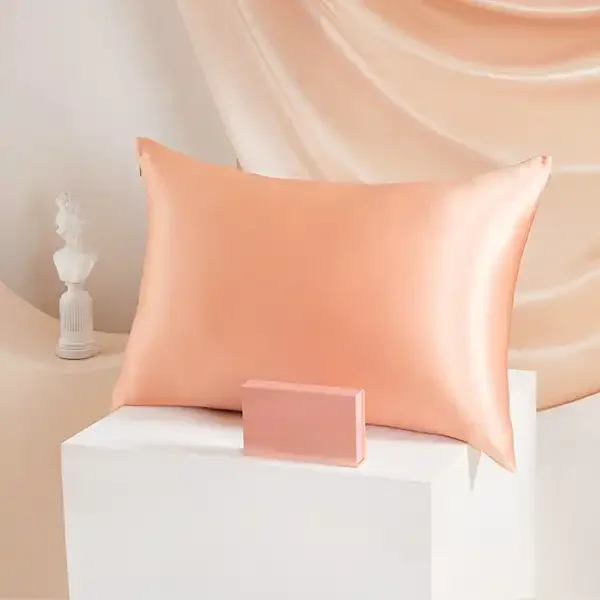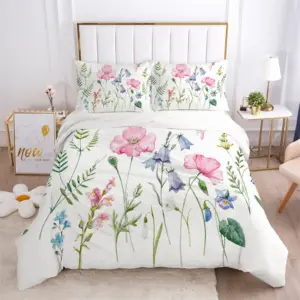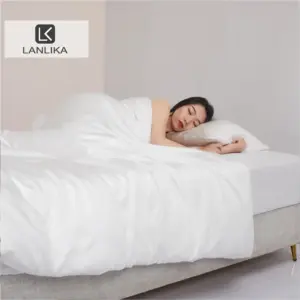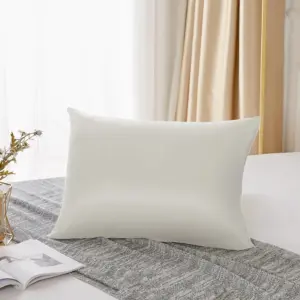Introduction: The Natural Allergy-Fighting Properties of Silk Sheets
Silk stands as nature’s premier hypoallergenic fabric, offering a remarkable combination of luxury and practical health benefits. Silk sheets are indeed hypoallergenic thanks to their unique natural composition and structure. The science behind this claim lies in silk’s protein makeup – specifically the presence of two key proteins: sericin and fibroin.
These natural proteins create a fabric that’s fundamentally different from common bedding materials. What makes silk truly special is how its molecular structure actively works to:
• Repel common allergens like dust mites and pet dander
• Resist moisture that leads to mold and mildew growth
• Provide a smooth surface that prevents allergen accumulation
• Offer natural antibacterial properties that keep your sleep environment clean
For centuries, individuals with sensitive skin have turned to silk for relief. Mulberry silk, the highest quality silk available, offers the most pronounced hypoallergenic benefits due to its long, uniform fibers and natural purity. When you choose silk sheets, you’re not simply indulging in luxury – you’re making a practical health decision that can significantly impact your sleep quality and overall wellness.
Understanding the hypoallergenic properties of silk fabric helps explain why it has been treasured for thousands of years as both a luxury and therapeutic material. The science that makes silk hypoallergenic involves complex natural mechanisms that synthetic fabrics simply cannot replicate. For those seeking the purest sleep experience, premium mulberry silk pillowcases offer an excellent introduction to silk’s hypoallergenic benefits.
What Makes Bedding Hypoallergenic?
The term “hypoallergenic” specifically refers to materials that are less likely to cause allergic reactions. When it comes to bedding, this quality becomes particularly important since we spend approximately one-third of our lives in direct contact with our sheets and pillowcases.
Conventional bedding materials often become reservoirs for common allergens due to their structure and composition. Cotton, for example, features short, fuzzy fibers that create countless microscopic spaces where allergens can become trapped and accumulate over time. These hidden allergens include:
• Dust mites (and their waste products)
• Pet dander
• Pollen
• Mold and mildew spores
• Bacteria
The fiber structure of bedding material plays a crucial role in determining its allergen resistance. Materials with rough, absorbent fibers tend to collect and harbor more allergens than those with smooth, tightly woven structures. Additionally, some fabrics naturally resist moisture, which deters the growth of mold, mildew, and dust mites.
Truly hypoallergenic bedding must address multiple allergy triggers simultaneously – from physical structure to moisture management to natural antimicrobial properties. This comprehensive approach is what makes certain materials stand out in their ability to create a cleaner sleep environment.
Understanding natural hypoallergenic fabrics provides important context for why certain materials perform better than others in creating allergy-friendly bedding.
Silk’s Natural Resistance to Dust Mites
Dust mites represent the primary allergen in most bedrooms, affecting up to 20 million Americans with allergic reactions ranging from mild irritation to severe respiratory distress. These microscopic creatures thrive in warm, humid environments and feed on the dead skin cells that naturally accumulate in bedding.
Silk’s unique structure creates an inhospitable environment for dust mites through several mechanisms:
• Tight Fiber Structure: Silk consists of exceptionally smooth, tightly woven fibers that leave minimal space for dust mites to penetrate and colonize.
• Natural Protein Barrier: The sericin protein in silk acts as a natural repellent to dust mites, creating a surface they struggle to cling to or burrow into.
• Low Moisture Retention: Silk’s ability to wick moisture away while remaining dry at the surface creates conditions that are too dry for dust mites to thrive.
• Temperature Regulation: Silk maintains a consistent temperature that discourages the warm, humid microenvironment dust mites prefer.
When comparing silk to cotton under microscopic examination, the difference becomes clear. Cotton’s short, fluffy fibers create countless nooks where dust mites can establish colonies, while silk’s long, smooth fibers present a uniform surface that offers little opportunity for infestation.
Scientific studies have consistently shown significantly reduced dust mite colonization in silk bedding compared to cotton alternatives. One study demonstrated up to 9.5 times fewer dust mites in silk bedding compared to cotton bedding used over the same period.
For those who suffer from allergies, silk bedding offers substantial relief through its natural resistance to these common triggers. Our collection of 100% silk sheets provides maximum hypoallergenic protection while offering unparalleled comfort.
Moisture-Wicking: Silk’s Defense Against Mold and Mildew
Mold and mildew in bedding can significantly contribute to respiratory allergies, causing symptoms like sneezing, congestion, and even triggering asthma attacks. These fungal growths thrive in damp, dark environments – precisely what can develop in bedding that retains moisture.
Silk’s exceptional moisture-wicking capabilities create a powerful defense against these allergens. The natural structure of silk allows it to:
• Absorb up to 30% of its weight in moisture while still feeling completely dry to the touch
• Efficiently draw moisture away from the body during sleep
• Release accumulated moisture into the air rather than retaining it
• Maintain consistent dryness throughout the night
This moisture management works in tandem with silk’s temperature regulation properties. By preventing humidity buildup in your bedding, silk creates an environment where mold and mildew simply cannot establish themselves.
Comparing silk to cotton reveals a stark difference in moisture handling:
| Feature | Silk | Cotton |
|---|---|---|
| Moisture absorption | 30% of weight while feeling dry | 27% of weight, feels damp |
| Drying time | Quick (2-3 hours) | Slow (8+ hours) |
| Moisture retention | Low | High |
| Mold resistance | Excellent | Poor |
Mold spores require moisture to reproduce and spread. By efficiently wicking away moisture and allowing it to evaporate, silk bedding interrupts the fundamental conditions needed for mold growth.
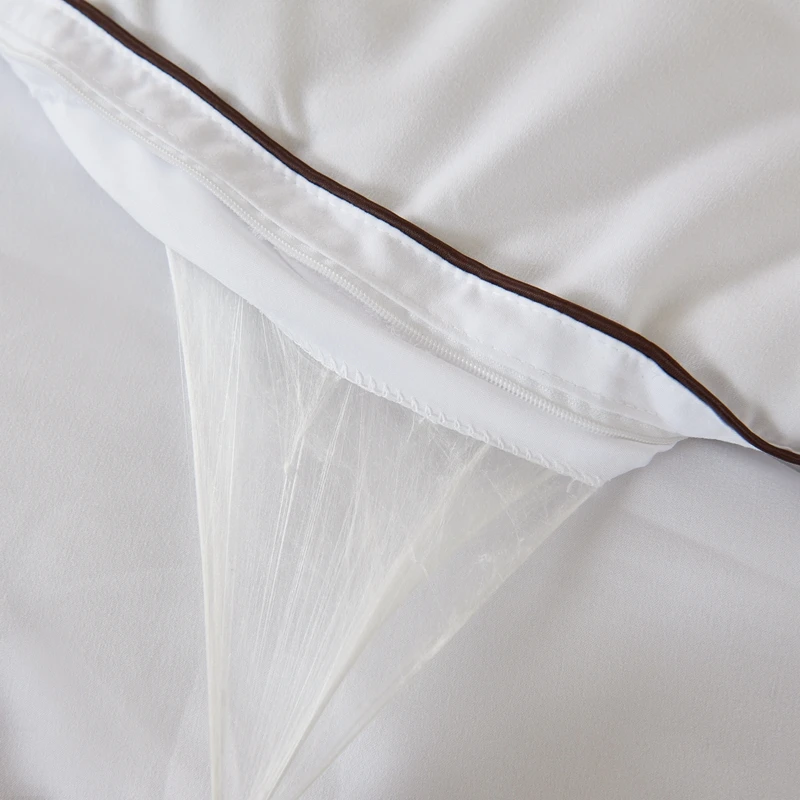
Our cooling silk sheets enhance these natural moisture-wicking properties, making them particularly beneficial for those prone to night sweats or living in humid climates.
The Smooth Surface Advantage: Minimizing Allergen Accumulation
At the microscopic level, silk fibers present a remarkably different landscape compared to other common bedding materials. Each silk fiber is smooth, uniform, and non-porous – resembling a polished cylindrical structure rather than the rough, irregular surface of cotton or synthetic fibers.
This smooth surface structure provides significant advantages for allergy sufferers:
• Common allergens like pollen, pet dander, and environmental particles struggle to adhere to silk’s slick surface
• Particles that do land on silk tend to slide off rather than becoming embedded in the fabric
• The lack of rough edges and loops means fewer places for allergens to become trapped
• The non-porous nature prevents particles from working their way inside the fiber structure
When comparing silk to cotton under a microscope, the difference becomes immediately apparent. Cotton fibers appear rough and irregular, with numerous small protrusions and cavities where particles can lodge themselves. Silk, by contrast, appears as smooth, continuous filaments offering minimal opportunity for allergen attachment.
This smooth surface also creates a significant benefit for those with sensitive skin. The reduced friction means less irritation, rubbing, and potential for skin reactions – particularly important for face, neck, and décolletage areas that directly contact pillowcases and top sheets.
The natural silk properties benefit sensitive skin in multiple ways, making it an ideal choice for those with eczema, psoriasis, or general skin sensitivities.
The Power of Natural Proteins: Sericin and Fibroin
Silk’s remarkable hypoallergenic properties stem largely from its unique protein composition. Each silk fiber consists of two primary proteins:
• Sericin: The outer layer that forms a protective coating with natural antibacterial and hypoallergenic properties
• Fibroin: The inner core that gives silk its strength, flexibility, and moisture-wicking ability
These proteins work together to create a material that actively resists common allergens and irritants. Research has demonstrated that sericin specifically has natural properties that repel dust mites and inhibit the growth of bacteria and fungi.
The amino acid profile of silk is particularly notable:
• Silk contains 18 amino acids that closely match those found in human skin
• These proteins are recognized as “friendly” by the human body, reducing the likelihood of reactions
• The amino acids create a slightly alkaline environment that discourages microbial growth
• The protein structure allows for breathability while maintaining a barrier against allergens
Studies examining the antimicrobial efficacy of silk proteins have shown significant inhibition of common bacteria like Staphylococcus aureus and E. coli compared to other natural fibers. This natural antimicrobial quality helps maintain a cleaner, more hygienic sleep environment.
Understanding the science behind silk’s hypoallergenic properties reveals why it performs so consistently well for allergy sufferers. Our mulberry silk sheets are crafted to preserve these natural protein structures, ensuring maximum hypoallergenic benefit.
Chemical-Free Purity: Why Processing Matters
High-quality silk, particularly Mulberry silk, undergoes minimal chemical processing compared to conventional bedding materials. This purity makes a significant difference for those with chemical sensitivities or allergies.
Conventional bedding often contains residual chemicals from manufacturing processes, including:
• Formaldehyde (used as a wrinkle-resistant treatment)
• Flame retardants
• Optical brighteners
• Harsh bleaching agents
• Synthetic dyes containing heavy metals
• Fabric softeners and finishers
These chemicals can trigger allergic reactions, skin irritation, and respiratory issues in sensitive individuals. By contrast, premium silk processing preserves the natural state of the fiber with minimal intervention.
Certification Matters: Look for OEKO-TEX Standard 100 certification, which guarantees that textiles have been tested for harmful substances and are safe from a human-ecological perspective. This certification ensures the silk has been processed without harmful chemicals.
Natural dyes and gentle processing methods preserve silk’s inherent hypoallergenic qualities. When silk undergoes excessive chemical treatment, it can compromise the natural protein structure that provides its allergy-fighting benefits.
When comparing different bedding options, silk consistently ranks as one of the most hypoallergenic fabrics available, especially when produced to high standards with minimal chemical intervention.
Temperature Regulation: The Climate Control Benefit
Silk possesses remarkable natural temperature-regulating properties that contribute significantly to its hypoallergenic performance. This “climate control” effect works in multiple ways:
• In warm conditions, silk allows excess heat to escape while wicking away moisture
• In cool conditions, silk creates an insulating layer that retains body heat without overheating
• The consistent temperature helps prevent excessive sweating that can trigger allergic reactions
• Silk’s breathability allows constant air circulation, preventing humid microclimates
This temperature stability creates an environment where allergens struggle to thrive. Dust mites, mold, and bacteria all prefer fluctuating conditions with periods of warmth and humidity – precisely what silk prevents.
The temperature regulation works hand-in-hand with silk’s moisture control properties:
• Less sweat accumulation means fewer skin irritants and allergens
• Consistent dryness prevents the damp conditions mold requires
• Stable temperature discourages dust mite reproduction
• Regulated microclimate reduces allergy triggers during sleep
For many allergy sufferers, nighttime symptoms intensify due to poor temperature regulation in conventional bedding. As cotton and synthetic materials trap heat and moisture, they create ideal conditions for allergen growth. Silk’s natural ability to maintain equilibrium prevents this problem.
The temperature control properties of silk sheets provide an additional layer of protection against allergic reactions. Our silk bedding sets offer comprehensive temperature regulation throughout your sleep environment.
100% Silk Sheets, Green Silk Sheets, King Size Silk Bedding Set, Mulberry Silk Bedding Sets, Queen Size Silk Bedding Set
Price range: $1,246.21 through $1,615.22 Select options This product has multiple variants. The options may be chosen on the product pageFull Silk Bedding Set, King Size Silk Bedding Set
Price range: $120.99 through $190.49 Select options This product has multiple variants. The options may be chosen on the product pageGrey Silk Sheets, Silk Sheet and Pillowcase Set
Price range: $88.20 through $146.64 Select options This product has multiple variants. The options may be chosen on the product pageBamboo Silk Sheets, Cooling Silk Sheets
Price range: $130.76 through $177.80 Select options This product has multiple variants. The options may be chosen on the product page100% Silk Sheets, King Size Silk Bedding Set, Mulberry Silk Bedding Sets, Queen Size Silk Bedding Set, White Silk Sheets
Price range: $1,000.79 through $1,351.42 Select options This product has multiple variants. The options may be chosen on the product pageKing Size Silk Pillowcases, Mulberry Silk Pillowcases, Queen Size Silk Pillowcases
Price range: $94.96 through $121.56 Select options This product has multiple variants. The options may be chosen on the product page
Relief for Respiratory Allergies: Asthma and Dust Mite Sensitivity
For individuals with respiratory allergies, the bedroom often becomes a challenging environment. Dust mite allergens, which include their microscopic waste particles, are particularly problematic because they become airborne easily and can be inhaled deeply into the lungs.
Silk bedding addresses this concern through multiple protective mechanisms:
• The natural dust mite resistance prevents the primary source of bedroom allergens
• Silk’s non-shedding fibers don’t release irritating particles into the air
• The smooth surface prevents the accumulation of allergens that could become airborne
• Proper moisture control prevents the humidity that can exacerbate respiratory symptoms
Many users with asthma and dust mite allergies report significant improvement after switching to silk bedding. One customer with lifelong asthma noticed reduced nighttime symptoms within weeks of changing to silk sheets, experiencing fewer attacks and less need for rescue inhalers during sleep.
“After years of waking up congested and wheezing, I finally enjoy mornings again. My silk sheets have made an incredible difference in my breathing quality overnight.” – A common sentiment among respiratory allergy sufferers who switch to silk.
The comprehensive protection silk offers combines physical barriers (smooth surface), environmental control (moisture and temperature regulation), and natural repellent properties to create a significantly cleaner breathing environment during sleep.
Research continues to support silk’s benefits for those with allergies, making it an increasingly recommended option by allergists for patients with persistent symptoms.
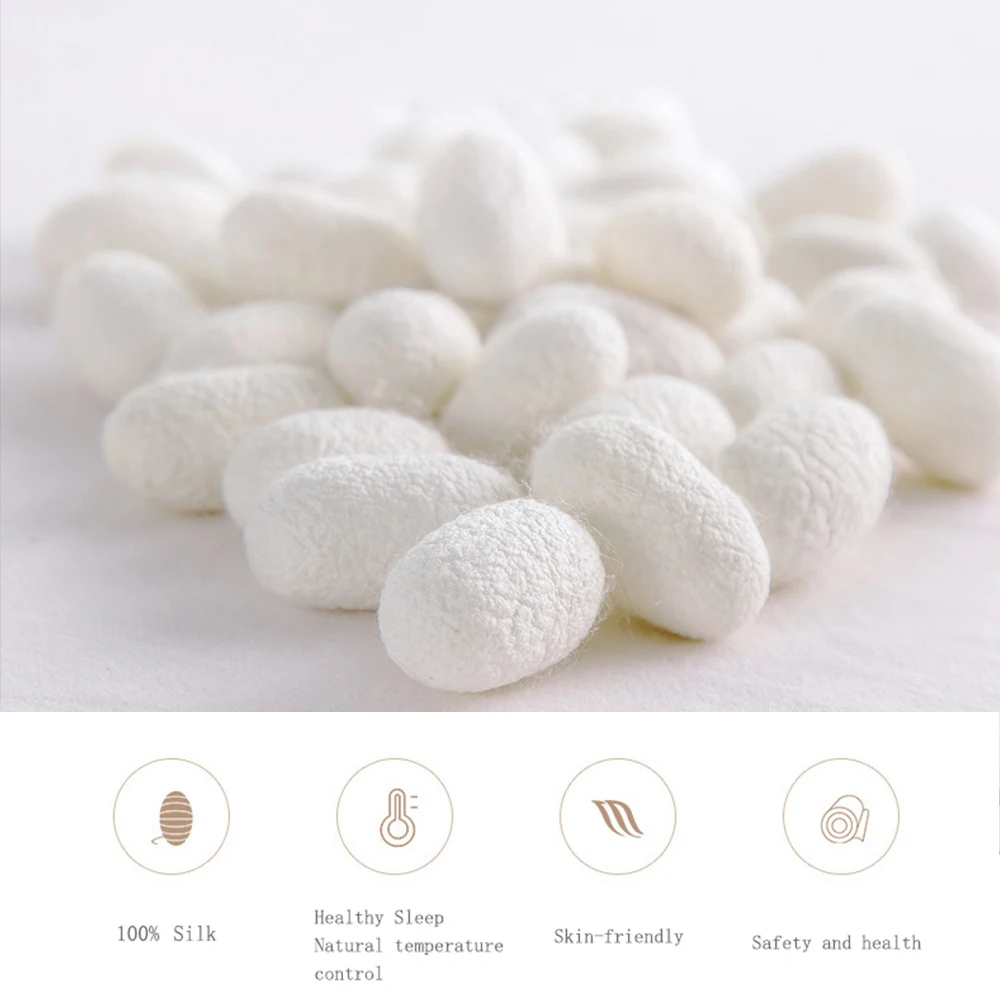
Soothing Sensitive Skin: Eczema, Psoriasis, and Contact Dermatitis
For those with sensitive skin conditions, bedding can either exacerbate symptoms or provide relief. Silk’s unique properties make it exceptionally beneficial for conditions like eczema, psoriasis, and contact dermatitis in several ways:
• Minimal Friction: Silk’s incredibly smooth surface creates virtually no friction against the skin, preventing the rubbing that can irritate sensitive areas. Cotton, by comparison, creates significantly more friction that can trigger flare-ups.
• Balanced Moisture: Silk helps maintain optimal skin hydration by retaining just enough moisture to prevent dryness while wicking away excess that could lead to irritation.
• Natural Proteins: The amino acids in silk proteins have a soothing effect on inflamed skin, helping to reduce redness and irritation over time.
• Temperature Stability: Silk prevents the overheating that often triggers increased itching and discomfort in skin conditions.
• Chemical-Free Comfort: Without harsh chemical residues that can trigger contact dermatitis, silk provides a pure surface for sensitive skin.
The difference becomes particularly noticeable with chronic skin conditions. Many eczema sufferers report reduced nighttime scratching and fewer morning flare-ups after switching to silk bedding. Those with psoriasis often notice less scaling and irritation on skin areas that come into direct contact with silk sheets.
The benefits of hypoallergenic silk fabric extend beyond preventing allergic reactions to actively soothing irritated skin. For face and hair care, our silk pillowcases provide direct contact benefits while you sleep.
Caring for Your Silk Sheets to Maintain Hypoallergenic Benefits
To preserve the hypoallergenic qualities of your silk sheets, proper care is essential. Following these guidelines ensures your silk maintains its allergy-fighting properties for years:
Washing Instructions:
• Hand wash or use your washing machine’s delicate/silk cycle with cold water (max 30°C/86°F)
• Use a pH-neutral, enzyme-free detergent specifically formulated for silk
• Avoid bleach, fabric softeners, and optical brighteners
• Turn silk sheets inside out before washing to protect the surface
Drying Methods:
• Never tumble dry silk sheets
• Gently squeeze out excess water without wringing
• Lay flat on a clean towel away from direct sunlight
• Allow to air dry completely before storing or using
Washing Frequency:
• For optimal allergen control, wash silk sheets every 7-10 days
• If you have severe allergies, consider weekly washing
• Always wash immediately if sheets are soiled or exposed to potential allergens
Detergent Selection:
• Choose mild, fragrance-free detergents
• Look for products specifically labeled safe for silk
• Avoid enzymes, brighteners, and harsh surfactants
• Consider pH-neutral baby shampoo as a gentle alternative
Storage Recommendations:
• Store completely dry silk in breathable cotton storage bags
• Avoid plastic containers that can trap moisture
• Add cedar blocks (not mothballs) to deter pests naturally
• Store in a cool, dry place away from direct sunlight
Following these care instructions preserves both the luxurious feel of silk and its hypoallergenic properties. Proper maintenance ensures your silk continues to resist dust mites, prevent allergen buildup, and maintain its smooth, non-irritating surface.
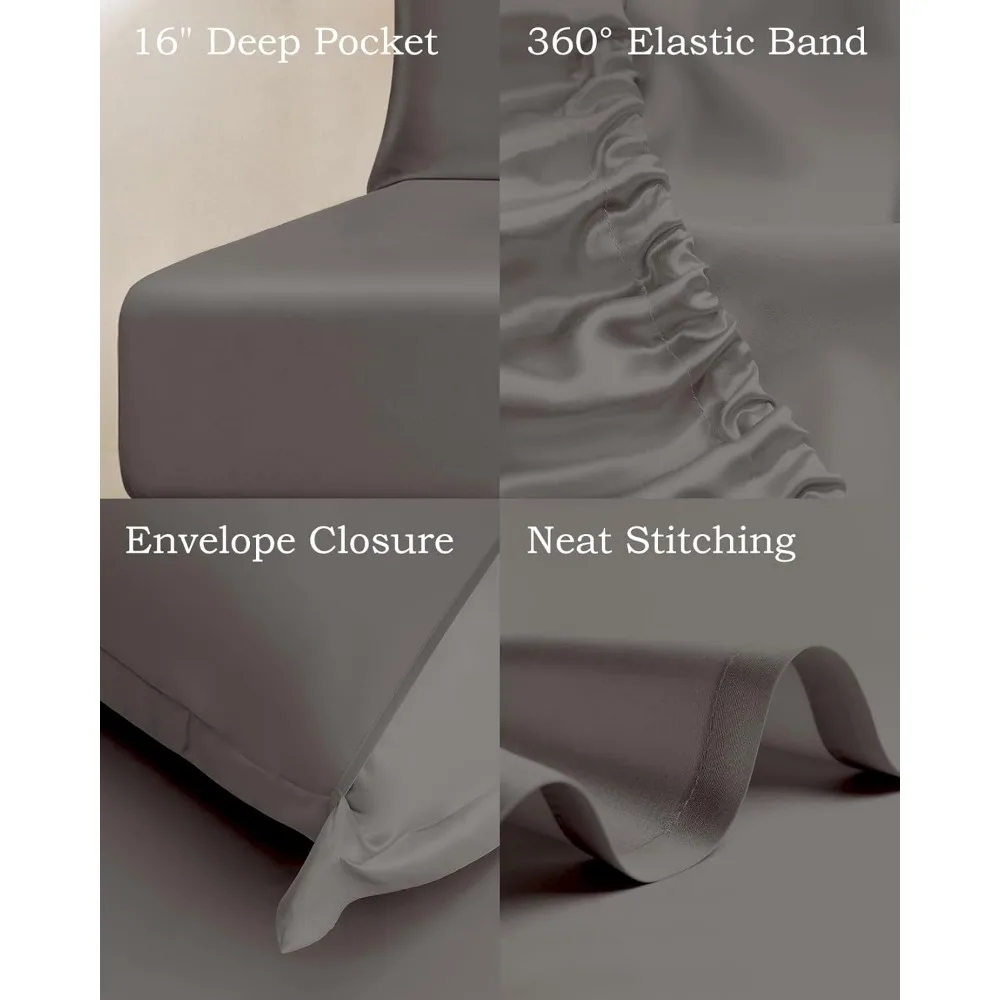
For more comprehensive information on creating an allergy-friendly bedroom, our complete guide to hypoallergenic bedding offers additional strategies and recommendations.
Is Silk Worth the Investment for Allergy Sufferers?
When considering silk sheets, many potential buyers hesitate at the higher price point compared to conventional bedding. For allergy sufferers, however, the question becomes more complex than simple cost comparison.
Pros of Investing in Silk:
• Significant reduction in common allergen exposure
• Potential decrease in allergy medication usage and associated costs
• Improved sleep quality leads to better overall health
• Durability – properly maintained silk can last for many years
• Multifunctional benefits addressing various allergies and sensitivities simultaneously
Considerations:
• Higher initial investment than cotton or synthetic alternatives
• Requires more careful maintenance
• Benefits may vary depending on individual sensitivity levels
• Quality matters – lower grade silk may not provide full hypoallergenic benefits
For those with moderate to severe allergies, silk bedding often represents more than a luxury purchase – it becomes a practical health investment. Many users report spending less on antihistamines, decongestants, and other allergy treatments after switching to silk bedding, potentially offsetting the initial cost over time.
Additionally, the improved sleep quality that comes from reduced nighttime symptoms can have far-reaching health benefits beyond allergy relief. Better sleep contributes to improved immunity, reduced inflammation, and better overall health outcomes.
The unique advantages of silk compared to cotton become particularly relevant for allergy sufferers. For those ready to make the investment, our luxury silk bedding sets provide comprehensive protection in one complete package.
Frequently Asked Questions About Silk and Allergies
Are all silk sheets equally hypoallergenic?
No, silk quality varies significantly. Mulberry silk with a higher momme weight (22-25) typically offers the best hypoallergenic properties due to tighter weaving and higher protein content. Lower quality silk or blended fabrics may not provide the same level of protection against allergens.
Can silk help with pet allergies specifically?
Yes, silk’s smooth surface prevents pet dander from becoming embedded in the fabric. While silk cannot prevent pet allergens from entering your bedroom, it does prevent them from accumulating in your bedding, reducing direct exposure during sleep.
How often should silk sheets be washed to maintain hypoallergenic properties?
For most people, washing silk sheets every 7-10 days is sufficient to prevent allergen buildup. Those with severe allergies may benefit from weekly washing. Always use gentle, enzyme-free detergents designed for silk.
Do silk sheets require special storage to prevent allergen buildup?
Yes, silk should be stored completely dry in breathable cotton storage bags rather than plastic containers that can trap moisture. Adding cedar blocks can naturally deter pests without introducing chemicals that might trigger sensitivities.
Are there any people who might be allergic to silk itself?
True silk allergies are extremely rare but possible. Most reactions attributed to “silk allergies” are actually responses to residual chemicals used in processing or dyes. High-quality, naturally processed silk like that used by Sanctuary Soft is much less likely to trigger reactions.
The exceptional benefits of mulberry silk sheets make them the gold standard for hypoallergenic bedding, providing the purest sleep environment possible through natural properties rather than chemical treatments.

